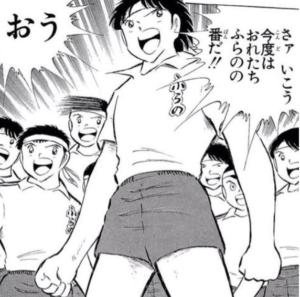Perhaps you’ve encountered some of these insects in your communities
Displaying both their predatory and defense characteristics
While embedded within the walls of flesh and passing for
What is most commonly recognized
As human
– Army Ants, Tom Waits
The year is 1985, a period often romanticized by anime fandom as a sort of “golden era.” Rintaro’s lavishly animated Dagger of Kamui hit theaters, Fight! Iczer One went from the pages of Lemon People onto home video as part of the nascent OVA market, and Akimi Yoshida’s Banana Fish premiered on the pages of Betsucomi. Otaku culture was spreading and becoming large enough to cater to fans on a broader scale. This was the same year Kadokawa released the first issue of its anime magazine Newtype, joining a plethora of magazines already on shelves including Animec, Animage, and their progenitor, Monthly OUT.

Often considered to be the first anime magazine (though it started out as a general subculture mag that shifted gears to ride the Space Battleship Yamato wave), Monthly OUT was published from 1977 until 1995. I found the following article by chance in the October 1985 issue of Monthly OUT and realized I had stumbled upon a fascinating example of fandom archaeology. It’s easy enough to know what anime people were watching in 1985, but it’s not often we get a look at what the fandom was like. This feature is a tongue-in-cheek parody of insect guides, but this time it holds a magnifying glass to the world of otaku. The piece is an irreverent jab that also hints at some unpleasant aspects of fandom that remain almost 35 years later. There’s a running strain of sexism, obsession with clothes as a status symbol, and contempt for cosplayers that are too pretty or too ugly. There’s also a pervasive sense of loathing, both self and externalized, though the illustrations are cute and cartoony.
Little is known about the artist for the feature, Panyome (the pen name of Takafumi Ieiri), but they were a regular contributor and illustrator for Monthly OUT. Outside of anime, they also drew character designs for games such as Wonder Boy in Monster World on the Sega Megadrive and was an illustrator for the popular Bikkuriman sticker series.
The Book of Otaku Insects
Translated by Laika
Translation Annotations
Jiyūgaoka: A fashionable neighborhood in southern Meguro, Tokyo known for gelato shops, trendy bars, and European architecture.
Mughi: A large cat-like creature that helps out Kei and Yuri in the series Dirty Pair. Fluffy and cute looking in the anime, but sleek and panther-like in the novel illustrations.
Koenji: Neighborhood known for its punk scene in the 1970s, it later became a retro fashion hub.
Dosukoi Sisters: A pair of sumo wrestling sisters from Choriki Robo Galatt.
Dump Matsumoto: Fearsome wrestler of the All Japan Women’s Pro-Wrestling (at the time this article was written).
Jumbo Miyamoto: One of Japan’s earlier women pro-wrestlers, she premiered in 1966 and retired in 1976, hence the article saying that’s an old reference.
Hey! Buddy: Magazine popular with otaku. Wonder why this bug likes it…
 Yellow Four: Probably a reference to Yellow 4, a member of the sentai show Choudenshi Bioman.
Yellow Four: Probably a reference to Yellow 4, a member of the sentai show Choudenshi Bioman.
Astro Myu 5/AstroMu 5: Toy series from 1973 of outer space warriors vaguely evocative of Ultraman.
Byakuya Shobo: Publishing house of Hey! Buddy! and other lolicon magazines.
Kinchan: Nickname for comedian Kinichi Hagimoto.
Fussa: City in the Kanto region that’s home to Yokota Air Base, a perfect town for a military otaku.
“Checkmate King 2”: A line from the American TV series Combat! Set during WWII.
Tokyo Phantom: Military surplus clothing store.
Mr. M and Mr. O: Probably referring to animators Hayao Miyazaki and Yasuo Ōtsuka.
 Clarisse: Lady Clarisse, the damsel Lupin rescues in Lupin III: Castle of Cagliostro.
Clarisse: Lady Clarisse, the damsel Lupin rescues in Lupin III: Castle of Cagliostro.
2CV: Referring to the Citroën 2CV, the car Clarisse is driving at the start of Castle of Cagliostro.
Sumi: Probably a reference to Shimamoto Sumi, voice actor of Clarisse in Castle of Cagliostro and Nausicaä in Nausicaä of the Valley of the Wind among many other roles.
Mushi Pro: The animation studio of Osamu Tezuka that also fostered talented animators including Osamu Dezaki, Rintaro and Yoshiaki Kawajiri.
Korekara no Watashi: “Me From Now On”, a book written by Shimamoto Sumi.
Mogura no Uta: “Song of the Mole”, a book by Toei animator Mori Yasuji.
Captain Tsubasa: Popular soccer manga by Yōichi Takahashi.
 The Character Skipper Butterfly’s shirt: Naturally a fan of Captain Tsubasa would wear clothes from the series too.
The Character Skipper Butterfly’s shirt: Naturally a fan of Captain Tsubasa would wear clothes from the series too.
The Checkers: Pop group full of cute high school boys that was extremely popular with girls in Japan during the 1980s.
Peanuts Train: Possibly a reference to the popularity of Charles Shultz’ beloved comic strip and also one of Chiba’s specialty crops
Captain Tsubasa high-school arc: One of the more melodrama-focused chapters in the beloved soccer manga.
Analysis
For most of the men in this piece, there is an element of duality to them. Either the balance of pride against shame or appearing benign/sociable to mask a dark intent. The “Lolicon” wears expensive golf clothes, carries around sophisticated doujinshi with an eclectic eye for collectibles, and a respectable job, while the article warns of a “darkness to him that can suck you in.” The “Old Days of Anime” Dragonfly places Gundam on a pedestal and covets his collection of Betamax tapes but “passes” for a normal salaryman with his work clothes and family. He’s sort of a less fashionable version of a character from Wotakoi, as he pines for a bygone era when Space Battleship Yamato ruled the airwaves. The “Panty Shot Shield Bug” is the analog equivalent of the modern-day con creep, with a cherubic face and a false press badge belying a hidden camera. The “Jaded Cricket” is simultaneously a self-proclaimed expert on doujinshi but can’t be bothered to buy or read new titles. He simply carries the affectation of a critic but without the spark of joy for the medium. The “Cel-Pusher Scarab” is an opportunist that is reviled just as much as he is patronized as a source of ill-gotten, but desirable goods.
Many of these archetypes would be echoed in 1991’s Otaku no Video, such as the salaryman that loves Gundam and the illicit cel pusher, but there’s no indication that that anime was directly influenced by this article.

The military otaku “Survival Rhino Beetle” is the odd man out in that he wears his fandom on his sleeves. His preferred doujinshi featuring “pretty girls carrying bazookas” is apropos considering 1985 was the same year Masamune Shirow’s Appleseed was released. His tendency towards wearing military drab and carrying airsoft guns echoes an action movie machismo rather than prepper paranoia, though he is very much the progenitor of the sort of cosplayers you see today dressed as Hunk from Resident Evil or Genome Soldiers from Metal Gear Solid. His aspect can also be seen in Kensuke (Shinji’s nerdy friend) from Evangelion.
The “Hard Sell Gossamer Butterfly,” “Character Skipper Butterfly,” “Cosplayers, and Happy Go Lucky” bugs all embody a resentment towards women in fandom as an invasive force that aren’t “true” fans. They’re just looking for money, attention, or indulging in the latest fad that involves cute boys. The “Hard Sell Butterfly” only cares about making money to the point where she can’t be bothered to read the doujinshi she’s selling. The “Cosplayer Swallowtail Butterfly” is chided for being too enthusiastic at her craft while her counterpart, the “Cosplay Vainmoth,” is mocked for not being good enough at it. This contempt is alive and well today where cosplayers are often derided for clogging convention hallways and mocked for being too ugly or too revealing. The “Character Skipper Butterfly” embodies emerging fan groups comprised of young women, but is dismissed as someone just following a fad and hoarding goods from the (then fairly new, since Animate first opened in 1983) anime stores. Her dismissal is similar to how the music of David Bowie was once regarded as just rock music for teen girls, but once something gains respectability or a larger fandom, the girls that discover the works are suddenly rejected from the narrative despite being on the ground floor of fandom. The “Pro Cicada” alone shows a sort of devotion to manga as a craft but languishes in obscurity while lamented for not dressing better.
Aspects of this humor can definitely be seen in works such as Otaku no Video, Di Gi Charat, Genshiken, and Wotakoi, as a badge of honor in anime fandom can also be seen as a burden of embarrassment. The world of anime and anime fandom is far removed from the world of 1985 in many respects, but this article shows that for as long as there has been fandom, the people that are a part of it are trapped in a web of loathing.
Support us on Patreon!
Contributor articles like this are supported in part by our readers. If you enjoyed this content, please consider supporting Zimmerit on Patreon.







